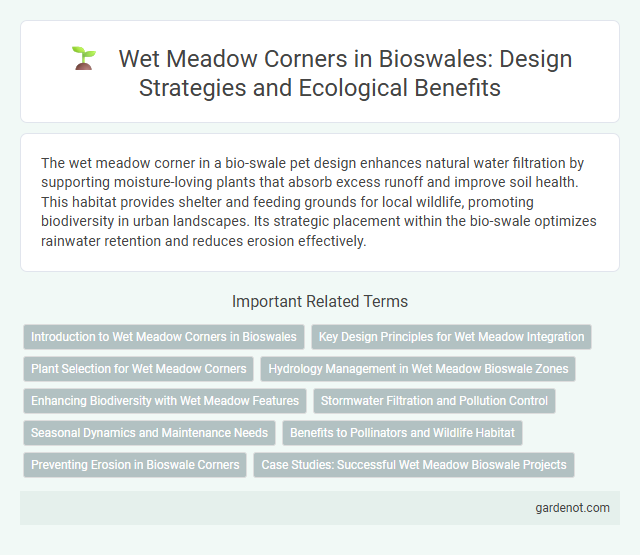The wet meadow corner in a bio-swale pet design enhances natural water filtration by supporting moisture-loving plants that absorb excess runoff and improve soil health. This habitat provides shelter and feeding grounds for local wildlife, promoting biodiversity in urban landscapes. Its strategic placement within the bio-swale optimizes rainwater retention and reduces erosion effectively.
Introduction to Wet Meadow Corners in Bioswales
Wet meadow corners in bioswales are designed to mimic natural wet meadow ecosystems, promoting water infiltration and pollutant removal through dense vegetation and rich soil mixtures. These areas support diverse native plants adapted to periodic flooding and saturated soils, enhancing habitat value and ecological resilience. Integrating wet meadow corners improves stormwater management by increasing retention time and fostering nutrient uptake in urban green infrastructure.
Key Design Principles for Wet Meadow Integration
Wet meadow corners in bio-swales utilize native, moisture-tolerant plant species that enhance water infiltration and support diverse wildlife habitats. Incorporating gentle slopes and varied soil compositions improves sediment capture while maintaining hydrological function. Strategic placement ensures optimal stormwater retention, reduces runoff velocity, and promotes pollutant removal through natural filtration processes.
Plant Selection for Wet Meadow Corners
Wet meadow corners thrive with native species like Carex stricta, Juncus effusus, and Eutrochium maculatum, which enhance water filtration and biodiversity. Selecting moisture-tolerant grasses such as Panicum virgatum and Schizachyrium scoparium supports soil stabilization and habitat creation. Incorporating a diverse mix of herbaceous plants ensures resilience and maximizes ecological benefits in bio-swale designs.
Hydrology Management in Wet Meadow Bioswale Zones
Wet meadow bioswale zones utilize hydrology management techniques that optimize water retention and slow stormwater runoff, promoting infiltration and reducing erosion. Native wet meadow vegetation stabilizes soil and enhances the filtration of pollutants from urban runoff. This strategic water control supports groundwater recharge while maintaining habitat for wetland flora and fauna.
Enhancing Biodiversity with Wet Meadow Features
Wet meadow corners in bio-swales provide essential habitat diversity by supporting native grasses and wildflowers. These features improve water infiltration while offering refuge for pollinators and amphibians, increasing overall ecosystem resilience. Incorporating wet meadow plants enhances nutrient cycling and stabilizes soil, promoting long-term biodiversity.
Stormwater Filtration and Pollution Control
Wet meadow corners in bio-swales enhance stormwater filtration by promoting infiltration through dense vegetation and permeable soils, effectively reducing runoff volumes. These areas trap sediments and absorb pollutants such as nitrogen, phosphorus, and heavy metals, improving water quality. Incorporating native wet meadow plants supports microbial activity that further breaks down contaminants, optimizing pollution control in urban landscapes.
Seasonal Dynamics and Maintenance Needs
Wet meadow corners in bio-swales exhibit dynamic seasonal changes, with native grasses and wildflowers flourishing in spring and summer while dormancy occurs in winter. Maintaining these areas requires periodic mowing after seed set to prevent woody plant encroachment and ensure optimal water infiltration. Seasonal monitoring of soil moisture and vegetation health supports sustained functionality and biodiversity within the bio-swale system.
Benefits to Pollinators and Wildlife Habitat
Wet meadow corners in bio-swales provide essential habitats that support diverse pollinators such as bees, butterflies, and hummingbirds by offering abundant native flowering plants and continuous nectar sources. These areas enhance biodiversity by creating microhabitats for various wildlife species, including amphibians, birds, and beneficial insects, contributing to ecological balance. The saturated soil conditions and plant diversity in wet meadow corners improve water filtration while sustaining the natural food web necessary for wildlife survival.
Preventing Erosion in Bioswale Corners
Wet meadow corners in bioswales play a crucial role in preventing erosion by stabilizing soil with deep-rooted native vegetation adapted to wet conditions. These plants enhance sediment capture and reduce runoff velocity, minimizing soil displacement at bioswale edges. Effective erosion control in bioswale corners improves water quality by filtering pollutants and supports habitat diversity in urban green infrastructure.
Case Studies: Successful Wet Meadow Bioswale Projects
Wet meadow bioswale projects such as the University of Washington's Rainier Valley Bioswale demonstrate effective stormwater management by combining native wet meadow vegetation with engineered soil systems, significantly reducing runoff volume and improving water quality. The City of Portland's Tryon Creek Bioswale integrates diverse wet meadow plants, enhancing urban biodiversity while mitigating pollutants through natural filtration processes. These case studies highlight the importance of site-specific plant selection and community engagement in achieving sustainable wet meadow bioswale performance.
Wet meadow corner Infographic

 gardenot.com
gardenot.com